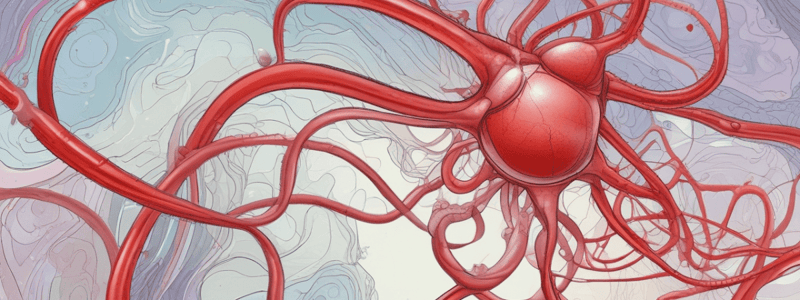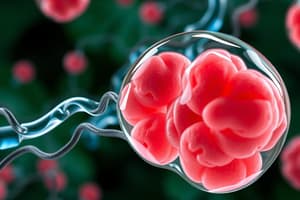Podcast
Questions and Answers
What is the primary function of the alveolus?
What is the primary function of the alveolus?
- To produce hemoglobin proteins
- To interface with blood vessels for gas exchange (correct)
- To transport oxygen to the blood vessels
- To store oxygen for future use
How does oxygen enter the red blood cell?
How does oxygen enter the red blood cell?
- Through diffusion (correct)
- Through facilitated diffusion
- Through osmosis
- Through active transport
What is the function of hemoglobin proteins in the red blood cell?
What is the function of hemoglobin proteins in the red blood cell?
- To regulate blood pressure
- To store oxygen for future use
- To produce carbon dioxide
- To transport oxygen to the body's tissues (correct)
How many oxygen molecules can bind to each hemoglobin protein?
How many oxygen molecules can bind to each hemoglobin protein?
What is the term for the process by which subsequent oxygen molecules bind more easily to hemoglobin?
What is the term for the process by which subsequent oxygen molecules bind more easily to hemoglobin?
What happens to the shape of hemoglobin when oxygen binds?
What happens to the shape of hemoglobin when oxygen binds?
What is an analogy that can be used to explain cooperativity?
What is an analogy that can be used to explain cooperativity?
What is the location where oxygen is transferred from the alveolus to the blood vessel?
What is the location where oxygen is transferred from the alveolus to the blood vessel?
What happens to the bicarbonate in the cell?
What happens to the bicarbonate in the cell?
What is the result of a proton binding to hemoglobin?
What is the result of a proton binding to hemoglobin?
Why does oxygen get delivered to the tissues?
Why does oxygen get delivered to the tissues?
What is the term for hemoglobin when it binds with oxygen?
What is the term for hemoglobin when it binds with oxygen?
What happens when carbon dioxide binds to hemoglobin?
What happens when carbon dioxide binds to hemoglobin?
What is the majority of oxygen transported in the blood through?
What is the majority of oxygen transported in the blood through?
What form does carbon dioxide take when it is transported from the thigh to the lung?
What form does carbon dioxide take when it is transported from the thigh to the lung?
What is produced by the tissue cell during cellular respiration?
What is produced by the tissue cell during cellular respiration?
What is the condition in the thigh that causes oxygen molecules to fall off hemoglobin?
What is the condition in the thigh that causes oxygen molecules to fall off hemoglobin?
What is the term for hemoglobin bound to carbon dioxide?
What is the term for hemoglobin bound to carbon dioxide?
What is the enzyme that combines CO2 and water to form carbonic acid?
What is the enzyme that combines CO2 and water to form carbonic acid?
What is the significance of the one-to-one ratio of protons bound to hemoglobin and bicarbonate in the plasma?
What is the significance of the one-to-one ratio of protons bound to hemoglobin and bicarbonate in the plasma?
What happens to the oxygen in the blood when it reaches the lung?
What happens to the oxygen in the blood when it reaches the lung?
What is the term for the dynamic process of oxygen binding and falling off hemoglobin?
What is the term for the dynamic process of oxygen binding and falling off hemoglobin?
What is the result of the reaction between CO2 and water facilitated by carbonic anhydrase?
What is the result of the reaction between CO2 and water facilitated by carbonic anhydrase?
What is the main difference between the blood leaving the thigh and the blood in the lung?
What is the main difference between the blood leaving the thigh and the blood in the lung?
Why does oxygen delivery occur in the thigh?
Why does oxygen delivery occur in the thigh?
What is the result of carbon dioxide competing with oxygen for binding to hemoglobin?
What is the result of carbon dioxide competing with oxygen for binding to hemoglobin?
What is the other reason for oxygen delivery besides low partial pressure of O2?
What is the other reason for oxygen delivery besides low partial pressure of O2?
What is the term for oxygen dissolved in plasma?
What is the term for oxygen dissolved in plasma?
What happens when oxygen enters the cell in the lung?
What happens when oxygen enters the cell in the lung?
What is the main reason for CO2 delivery back to the lungs?
What is the main reason for CO2 delivery back to the lungs?
What is the result of oxygen competing with protons and CO2 for hemoglobin?
What is the result of oxygen competing with protons and CO2 for hemoglobin?
What is the role of bicarbonate in the blood?
What is the role of bicarbonate in the blood?
What is the net result of the reaction when oxygen binds to hemoglobin?
What is the net result of the reaction when oxygen binds to hemoglobin?
What is the primary way that CO2 is transported back to the lungs?
What is the primary way that CO2 is transported back to the lungs?
What is the result of the reversible reaction involving H2CO3?
What is the result of the reversible reaction involving H2CO3?
What is the role of carbonic anhydrase in the reaction?
What is the role of carbonic anhydrase in the reaction?
What is the direction of the diffusion gradient in the lung?
What is the direction of the diffusion gradient in the lung?
What is the net result of the entire process of CO2 delivery back to the lungs?
What is the net result of the entire process of CO2 delivery back to the lungs?
Flashcards are hidden until you start studying
Study Notes
Oxygen Transportation
- Oxygen diffuses from the alveolus into the blood vessel and then into a red blood cell through diffusion.
- Oxygen binds to hemoglobin (Hb) in the red blood cell, with each hemoglobin protein having four parts that can bind an oxygen.
- Cooperativity occurs, where each oxygen binding to hemoglobin makes it easier for subsequent oxygens to bind, changing the conformation or shape of hemoglobin.
- There are two major ways oxygen is transported in the blood: hemoglobin binding oxygen (HbO2) and some oxygen being dissolved in plasma (O2).
Oxygen Delivery
- Oxygen is delivered to the tissues due to the low partial pressure of oxygen (pO2) in the tissues, causing oxygen to fall off the hemoglobin.
- Another reason for oxygen delivery is the binding of protons and carbon dioxide (CO2) with hemoglobin, competing with oxygen for binding sites.
- CO2 is produced by cellular respiration and diffuses into the red blood cell, where it combines with water to form carbonic acid (H2CO3) with the help of carbonic anhydrase.
- The bicarbonate (HCO3-) formed from carbonic acid diffuses out of the cell, while the proton (H+) binds to hemoglobin, booting off oxygen.
Carbon Dioxide Transportation
- Carbon dioxide is transported back to the lungs through three different ways:
- CO2 dissolved in plasma
- CO2 bound to hemoglobin as carbaminohemoglobin
- Bicarbonate (HCO3-) in plasma, which combines with protons to form CO2
- In the lungs, oxygen competes with protons and CO2 for hemoglobin binding sites, causing CO2 to be released.
- The low CO2 content in the lungs allows CO2 to diffuse into the alveolus.
- The most important mechanism for CO2 transportation is the binding of protons to hemoglobin, which leads to the formation of CO2 from bicarbonate in the plasma.
Studying That Suits You
Use AI to generate personalized quizzes and flashcards to suit your learning preferences.




